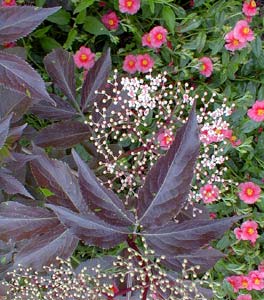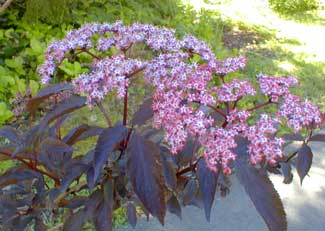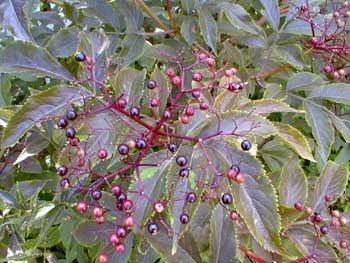
Myths & Legends
of Black Elderberry
"Toward the dusty
elderberry falls the ruddy
blossoms of stars
& pallid lips speak
one word: 'Death!'"
- Sigitas Zigmas Geda
b. 1943, Lithuania
b. 1943, Lithuania
Part of the joy I get from gardening is from the rich array of fantastical belief & legend that surrounds plants. When the weather is too nasty to garden, or it's too late in the day, reading about the history & mythology of things growing in our yards extends the garden's impact not only on the senses, but on the intellect & the imagination.
Shortly after Granny Artemis & I bought our house, one of the "weeds" that was erupting in the neglected yards was Sambucus racemosa, vis, Red Elderberry, which is a small tree or huge shrub. Ours is a wild variety from right here on the Kitsap & Olympic penninsulas, but Elderberry grows around the globe in the northern hemisphere, & we also have a young specimen of Europe's S. nigra, vis, Black Elderberry, of which we have to cultivars, 'Purpurea' shown in the first photo together with sunrose blossoms underneath it & in the third photo with unripe berries; plus 'Black Beauty' shown in May flower in the second photo.
Black Elderberry was especially prone to attracting quite the array of mythology. It was sacred in Saxony. It could not be cut down unless propitiated. Arnkiel wrote that his Saxon forefathers regarded it in the manner of a Goddess, addressing her as Dame Ellhorn while upon one knee with bared head & hands clasped in attitude of prayer, begging her permission to use her wood. In ancient & medieval Lettonie (Lithuania) the Lettons believed their god Pushkait dwelt beneath the elderberry, & he received offerings of bread & beer under the branches of Dame Ellhorn.
 In Norse & Teutonic myth, this same Black Elderberry was sacred to the cthonic goddess Hulda, & in the later period of the scalds, to Freya or to Frigg, & it was within the Elder Tree that Freya dwelt. The elderberry's Danish name is Hyld, after the Goddess cum Queen of the Fairies. In German she is Dame Holda (i.e., "Lady Elder"), & was an Aphrodite-like divinity who decayed into a fairy-genius or dryad of the elder tree. She recurs in marchen (fairy tales) as a patroness of spinsters. Since Freya came to be regarded as a Goddess of witchcraft, elders were in medieval times called Witches' Trees. It was believed that if an infant were placed in a cradle made of elderberry wood, the fairies would pinch the baby until it was black & blue.
In Norse & Teutonic myth, this same Black Elderberry was sacred to the cthonic goddess Hulda, & in the later period of the scalds, to Freya or to Frigg, & it was within the Elder Tree that Freya dwelt. The elderberry's Danish name is Hyld, after the Goddess cum Queen of the Fairies. In German she is Dame Holda (i.e., "Lady Elder"), & was an Aphrodite-like divinity who decayed into a fairy-genius or dryad of the elder tree. She recurs in marchen (fairy tales) as a patroness of spinsters. Since Freya came to be regarded as a Goddess of witchcraft, elders were in medieval times called Witches' Trees. It was believed that if an infant were placed in a cradle made of elderberry wood, the fairies would pinch the baby until it was black & blue. Snow was said to result from Hulda shaking out the quilts & covers of her bed. Hulda, Hulta, or Holda was an archaic Earthmother, Moon Goddess, Hearth Mother, & Wind-goddess with rule over the weather, & whose name was synonymous with Elder. She was also called Holle or Holla, which means Sacred, but this name eventually came to be associated with the European Holy Tree. Hulda's mythology of the Elderberry is frequently compounded with with Frigga's Holly mythology, & Hulda's title "Holy" (Holle) became Frigga's title.
But the trees were not actually confused, & Frigga's wintery holly mythology did once belong to Hulda, who as a Maiden dwelt in the summer-fruiting Elder Tree bestowing fertility on the world, but who as the Winter Hag dwelt in the winter-fruited Holly Tree, the tree which had leaves & fruit even in the unfruitive season. Akin to Persephone, Hulda was forced to marry a Death-god named Holler, whom we may identify with the Holly King who in Celtic myth ruled winter & death.
So the beneficence of Hulda's warm hearth was joined ultimately with the fires of the underworld. And long-lingering prohibitions of burning the wood either of holly or of elder is because the hearthfire has this deathly connection, & smoke of holly or elder can release underworld spirits. In medieval times Hulda compounded with Frigga was recalled as Frau Holly, the Queen of Witches, who dwelt in holly branches, but she had once also been Lady Elderberry, Sovereign of Spring, comparable to Persephone who ruled Death half each year, & Life the other half. So too Freya or Frigga though originally a fertility goddess became in medieval times a powerful witch, whose coven could be held at bay with protective sprigs of holly or elder.
The association of the Elder Tree with death is commemorated in many a weird poem. William Wordsworth (1770-1850) wrote of
"The elder-tree that grewWhile in "The Death-Child" by William Sharp (1837-1895), the poet fathoms a ghost beneath an obvious choiced of tree, the elder. This poem is quoted here in its entirety:
Beside the well-known charnel-house had then
A dismal look."
She sits beneath the elder-tree
And sings her song so sweet,
And dreams o'er the burn that darksomely
Runs by her moonwhite feet.
Her hair is dark as starless night,
Her flower-crowned face is pale,
But oh, her eyes are lit with light
Of dread ancestral bale.
She sings an eerie song, so wild
With immemorial dule--
Though young and fair, Death's mortal child
That sits by that dark pool.
And oft she cries an eldritch scream,
When red with human blood
The burn becomes a crimson stream,
A wild, red, surging flood:
Or shrinks, when some swift tide of tears--
The weeping of the world--
Dark eddying 'neath man's phantom-fears
Is o'er the red stream hurled.
For hours beneath the elder-tree
She broods beside the stream;
Her dark eyes filled with mystery,
Her dark soul rapt in dream.
The lapsing flow she heedeth not
Through deepest depths she scans:
Life is the shade that clouds her thought,
As Death 's the eclipse of man's.
Time seems but as a bitter thing
Remembered from of yore:
Yet ah (she thinks) her song she'll sing
When Time's long reign is o'er.
Erstwhiles she bends alow to hear
What the swift water sings,
The torrent running darkly clear
With secrets of all things.
And then she smiles a strange sad smile
And lets her harp lie long;
The death-waves oft may rise the while,
She greets them with no song.
Few ever cross that dreary moor,
Few see that flower-crowned head;
But whoso knows that wild song's lure
Knoweth that he is dead.
Hulda's name also means "Sacred Spirit." This Spirit was the spark of life that infused humanity, i.e., a fragment of Hulda provides us with a Soul, for without her fiery ether all things are inert. Even the hearth-fire tended by a wife, which cooked food & warmed the family, contained Huldas spirit-fire, making her a type of Vesta or Cybele whose sacred fire was tended in Rome by the Vestal Virgins. This Fire is simultaneously the atmosphere we breathe, surrounding us at all times, which permits us to live, so that the Spirit which is our soul is a compound of Air & Fire.
By a widespread myth promulgated especially by early Gnostics, the Sun & Moon had once been equal in brightness, but the Moon spun out her spirit into the world in the process of birthing all that lives. In a future age of dissolution, when parity is restored between Sun & Moon, all that lives will be restored to the perfection of the Divine Realm. In the Norse version, this energy which spun out of Hulda left a cosmic trail, which we perceive as the Milky Way, called "Hulda's Road" or "Road of Souls," by which the souls of the dead find their way back to their origin.
 As Queen of Souls she is easily identified with the Teutonic underworld goddess Hel, whose name means "The Covered One" or "Hidden," alluding both to her Hecate-like sovereignty in the hidden land, & to her spark hidden within each of us, unseen but causing life. It should be recalled that in the oldest level of Norse myth, Hel's realm was not Hell as we today think of it, but a paradise of souls, akin to Valhalla but not restricted to the heroic war-dead. Only much later did Hel's High Hall become a place of judgement, of punishment or reward.
As Queen of Souls she is easily identified with the Teutonic underworld goddess Hel, whose name means "The Covered One" or "Hidden," alluding both to her Hecate-like sovereignty in the hidden land, & to her spark hidden within each of us, unseen but causing life. It should be recalled that in the oldest level of Norse myth, Hel's realm was not Hell as we today think of it, but a paradise of souls, akin to Valhalla but not restricted to the heroic war-dead. Only much later did Hel's High Hall become a place of judgement, of punishment or reward.Though Hulda is at base the cause of all that lives, by having first conferred Life she simultaneously brought about the existence of Death. She can at any moment turn from a soft breeze to roiling clouds bright with destructive lightning. By a close pun, Hulda's name meant "Combat" (Hilda), a common name for mortal shieldmaidens & supernatural valkyries. The name Elder is derived from an Anglo-Saxon word Aeld meaning "Fire," for the Elderberry Goddess was fiery when roused, though this "Fire" was the same spark of life called Spirit, a necessary though volatile thing for the perpetuation of this troubled world.
Elder or Aeld also associated this tree with Fairyland or Eld. In Celtic lore it was said that if one sat under an elderberry tree on Midsummer's Eve when its berries were ripe, it was possible to see the Fairy King pass by in a procession. So too in Ireland a solitary elder tree would be avoided because mischievous fairies dwelt in it. The myth of the Summer King passing by the fruiting elderberry again contrasts to a myth of Hulda in winter, as the Hag who leads a parade of souls to the land of the dead. In a christianized variant that persisted into the modern era among rural folk of Denmark & Germany, the Wintery Hulda leads the ghosts of unbaptised children. She persisted in fairy tales as the witchlike Fairy Godmother, dubious guardian usually to some infant girl.
There was a tension in the Christian age between demeaning the elder tree as unlucky because of its longstanding pagan associations, or of coopting the mythology as their own. Of course the tensions between her balance of Life-giving & Death-bringing propensities were always present, & like Persephone the Maid, even as Queen of the Underworld, Hulda was protector of souls & not a punisher. Later christians could pick & choose which elements of Her mythology to deplore or coopt.
So while on the one hand a small cross made of elder wood could be placed on the outside of a barn to protect livestock, the elder was otherwise associated with death, witchcraft, & unluckiness. The cross upon which Jesus was killed was made of elder wood. Judas hanged himself from a branch of an elder tree, his ill-gotten coins scattered on the ground beneath his dangling feet. And furniture made of elder was regarded as cursed & attractive to the devil, whose very throne was made of elder.
For all that, Christian peoples continued to value the elder tree for its healing properties, & many said leaves of an elder warded off witch's curses. The Devil's affinity for elder could be turned against him if branches were placed in a trap for him. Elderberries gathered on St. John's Eve (June 21) could be used to repell mosquitos, serpents, toothache, & other evils. Even the Judas connection was reclaimed, as a book published in 1644 entirely about the virtuous elder tree noted that a fungus called Judas's Ear which grew only on the elder tree was a potent medicine for soar throats & quinsy, while a medicine derived from the tree itself purportedly cured everything up to & including the Black Plague.
Elder was said to cure rheumatism merely by taking twigs, weaving them into hoops, & wearing them about the aching part of the body. Others would take a little bathwater from a sick person's bath & give the water to an elder tree, with the belief that the tree would then absorb the illness into itself. This association of Black Elder with death & disease, & with healing & cures, is curiously reflective of the traits of the cthonic Hulda, whose ancient cult has diminished to a few beliefs & superstitions about Her sacred tree.
See also
Sambucus nigra 'Black Beauty'
& see the
Main Sambucus nigra 'Purpurea' page
as well as the
'Purpurea' Elderberry page in the Berries Gallery
& for good measure the
Sambucus racemosa pubens Pacific Red Elderberry
not to mention the fancy
Sambucus racemosa 'Sutherland Golden'
Sambucus nigra 'Black Beauty'
& see the
Main Sambucus nigra 'Purpurea' page
as well as the
'Purpurea' Elderberry page in the Berries Gallery
& for good measure the
Sambucus racemosa pubens Pacific Red Elderberry
not to mention the fancy
Sambucus racemosa 'Sutherland Golden'